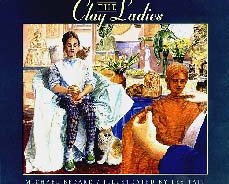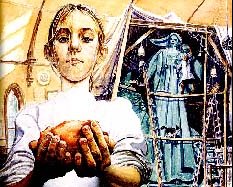|
________________
CM . . . .
Volume VI Number 12 . . . . February 18, 2000


|
The Clay Ladies.
Michael Bedard. Illustrated by Les Tait.
Toronto, ON: Tundra Books, 1999.
40 pp., cloth, $19.99.
ISBN 0-88776-385-5.
Subject Headings:
Loring, Frances, 1887-1968-Juvenile fiction.
Wyle, Florence, 1881-1968-Juvenile fiction.
Women sculptors-Juvenile fiction.
Intergenerational relations-Juvenile fiction.
Grades 3-6 / Ages 8-11.
Review by Val Nielsen.
*** /4
|

 In The Clay Ladies, Michael Bedard has once again shown his ability to bring to life literary and
artistic figures of the past by a skillful blending of fact and fiction. Previous picture books have
included Emily (1992), a tale involving a young girl's friendship with Emily Dickinson, and
The Divide (1997), a story of nine-year old Willa Cather's move to Nebraska. In The Clay
Ladies, Bedard uses a fictitious incident to create a story based on the lives of two real-life clay
sculptors, Frances Loring and Florence Wylie, who lived and worked in Toronto from the 1920's
to the 1960's. This eccentric pair, known to their neighbours as "The Clay Ladies," lived in an old
building "...painted red, with pointed windows and a steep pitched roof...called the Church, for it
had been one once, but was no more." The narrator of The Clay Ladies is a grandmother who
re-creates a story from her girlhood for her small grandson. As a child, she tells him, she often hid
behind the hedge watching the Clay Ladies, noticing that children would sometimes bring sick or
injured pets to the Church. One day, the little girl rescues a wounded bird from a cat and knows
just where to take it. She is welcomed by Frances Loring who takes her into the old house
where she is greeted by a magnificent jumble of half-finished sculptures, towering pieces of
pottery and mysterious things draped with wet cloths, all interspersed with cats, sleeping, lurking
and prowling. The little girl takes the young robin to Florence Wylie, a small, sharp woman in a
clay-smeared smock, who finds a cage for the fledgling to live in until his feathers grow. Drawn
by the kindness and compassion of the two sculptors and the wonders inside their domain, the
little girl makes many return visits to the Church. Inevitably, one of the Clay Ladies gives her a
lump of clay, and she is on her way to finding the creative powers within her.
In The Clay Ladies, Michael Bedard has once again shown his ability to bring to life literary and
artistic figures of the past by a skillful blending of fact and fiction. Previous picture books have
included Emily (1992), a tale involving a young girl's friendship with Emily Dickinson, and
The Divide (1997), a story of nine-year old Willa Cather's move to Nebraska. In The Clay
Ladies, Bedard uses a fictitious incident to create a story based on the lives of two real-life clay
sculptors, Frances Loring and Florence Wylie, who lived and worked in Toronto from the 1920's
to the 1960's. This eccentric pair, known to their neighbours as "The Clay Ladies," lived in an old
building "...painted red, with pointed windows and a steep pitched roof...called the Church, for it
had been one once, but was no more." The narrator of The Clay Ladies is a grandmother who
re-creates a story from her girlhood for her small grandson. As a child, she tells him, she often hid
behind the hedge watching the Clay Ladies, noticing that children would sometimes bring sick or
injured pets to the Church. One day, the little girl rescues a wounded bird from a cat and knows
just where to take it. She is welcomed by Frances Loring who takes her into the old house
where she is greeted by a magnificent jumble of half-finished sculptures, towering pieces of
pottery and mysterious things draped with wet cloths, all interspersed with cats, sleeping, lurking
and prowling. The little girl takes the young robin to Florence Wylie, a small, sharp woman in a
clay-smeared smock, who finds a cage for the fledgling to live in until his feathers grow. Drawn
by the kindness and compassion of the two sculptors and the wonders inside their domain, the
little girl makes many return visits to the Church. Inevitably, one of the Clay Ladies gives her a
lump of clay, and she is on her way to finding the creative powers within her.
Toronto artist Les Tait, whose illustrations for Sheldon Oberman's The White Stone in the
Castle Wall helped that book become a finalist for the Ruth Schwartz award, has filled his
paintings with authentic detail, including some of the sculptors' best known work. His use of cool,
bright colours evokes a mood of serenity, giving the reader an eye-filling picture of the wilderness
outside the old church as well as the clutter of creativity within.
Although Bedard's prose is graceful and his exploration of the mystery of creative inspiration an
appealing theme, the story is somewhat thin and unlikely to hold the attention of younger children
for long (although they will almost certainly enjoy hunting for the multitude of cats to be found
hiding out in unexpected places in each painting). Art teachers might find The Clay Ladies
useful as an introduction to a sculpting activity or a unit on sculpture.
Recommended.
Valerie Nielsen is a retired teacher-librarian living in Winnipeg, MB.

To comment on this title or this review, send mail to cm@umanitoba.ca.
Copyright © the Manitoba Library Association.
Reproduction for personal use is permitted only if this copyright notice
is maintained. Any other reproduction is prohibited without
permission.
Published by
The Manitoba Library Association
ISSN 1201-9364
TABLE OF CONTENTS FOR THIS ISSUE - February 18,
2000.
AUTHORS |
TITLES |
MEDIA REVIEWS |
PROFILES |
BACK ISSUES |
SEARCH |
CMARCHIVE |
HOME
|

 In The Clay Ladies, Michael Bedard has once again shown his ability to bring to life literary and
artistic figures of the past by a skillful blending of fact and fiction. Previous picture books have
included Emily (1992), a tale involving a young girl's friendship with Emily Dickinson, and
The Divide (1997), a story of nine-year old Willa Cather's move to Nebraska. In The Clay
Ladies, Bedard uses a fictitious incident to create a story based on the lives of two real-life clay
sculptors, Frances Loring and Florence Wylie, who lived and worked in Toronto from the 1920's
to the 1960's. This eccentric pair, known to their neighbours as "The Clay Ladies," lived in an old
building "...painted red, with pointed windows and a steep pitched roof...called the Church, for it
had been one once, but was no more." The narrator of The Clay Ladies is a grandmother who
re-creates a story from her girlhood for her small grandson. As a child, she tells him, she often hid
behind the hedge watching the Clay Ladies, noticing that children would sometimes bring sick or
injured pets to the Church. One day, the little girl rescues a wounded bird from a cat and knows
just where to take it. She is welcomed by Frances Loring who takes her into the old house
where she is greeted by a magnificent jumble of half-finished sculptures, towering pieces of
pottery and mysterious things draped with wet cloths, all interspersed with cats, sleeping, lurking
and prowling. The little girl takes the young robin to Florence Wylie, a small, sharp woman in a
clay-smeared smock, who finds a cage for the fledgling to live in until his feathers grow. Drawn
by the kindness and compassion of the two sculptors and the wonders inside their domain, the
little girl makes many return visits to the Church. Inevitably, one of the Clay Ladies gives her a
lump of clay, and she is on her way to finding the creative powers within her.
In The Clay Ladies, Michael Bedard has once again shown his ability to bring to life literary and
artistic figures of the past by a skillful blending of fact and fiction. Previous picture books have
included Emily (1992), a tale involving a young girl's friendship with Emily Dickinson, and
The Divide (1997), a story of nine-year old Willa Cather's move to Nebraska. In The Clay
Ladies, Bedard uses a fictitious incident to create a story based on the lives of two real-life clay
sculptors, Frances Loring and Florence Wylie, who lived and worked in Toronto from the 1920's
to the 1960's. This eccentric pair, known to their neighbours as "The Clay Ladies," lived in an old
building "...painted red, with pointed windows and a steep pitched roof...called the Church, for it
had been one once, but was no more." The narrator of The Clay Ladies is a grandmother who
re-creates a story from her girlhood for her small grandson. As a child, she tells him, she often hid
behind the hedge watching the Clay Ladies, noticing that children would sometimes bring sick or
injured pets to the Church. One day, the little girl rescues a wounded bird from a cat and knows
just where to take it. She is welcomed by Frances Loring who takes her into the old house
where she is greeted by a magnificent jumble of half-finished sculptures, towering pieces of
pottery and mysterious things draped with wet cloths, all interspersed with cats, sleeping, lurking
and prowling. The little girl takes the young robin to Florence Wylie, a small, sharp woman in a
clay-smeared smock, who finds a cage for the fledgling to live in until his feathers grow. Drawn
by the kindness and compassion of the two sculptors and the wonders inside their domain, the
little girl makes many return visits to the Church. Inevitably, one of the Clay Ladies gives her a
lump of clay, and she is on her way to finding the creative powers within her.